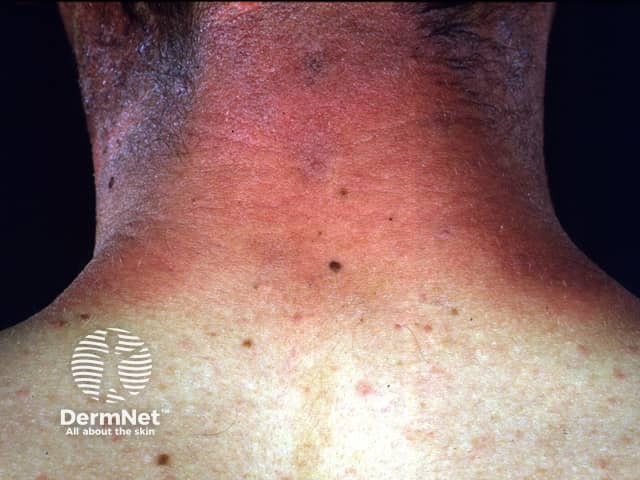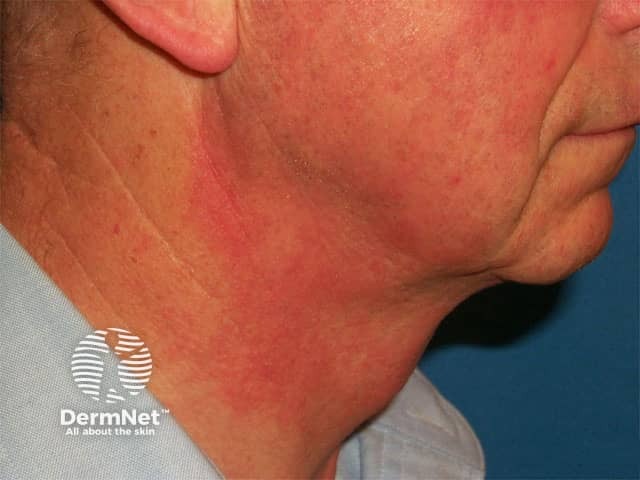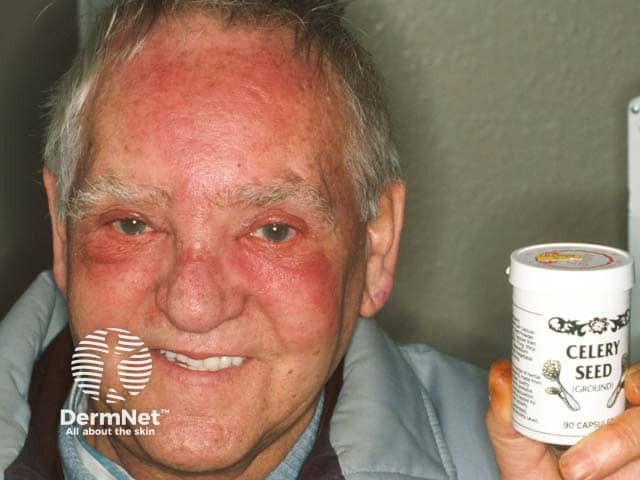Main menu
Common skin conditions

NEWS
Join DermNet PRO
Read more
Quick links
Photocontact dermatitis — extra information
Photocontact dermatitis
March 2023
Author(s): Dr Ahmed Tahoun, Dermatologist, Menoufia University, Egypt (2023)
Previous contributors: Vanessa Ngan, Staff Writer (2006)
Reviewing dermatologist: Dr Ian Coulson
Edited by the DermNet content department
Introduction Demographics Causes Causes - phototoxic contact dermatitis Causes - photoallergic contact dermatitis Clinical features Clinical features - phototoxic contact dermatitis Clinical features - photoallergic contact dermatitis Variation in skin types Complications Diagnosis Differential diagnoses Treatment Prevention Outcome
What is photocontact dermatitis?
Photocontact dermatitis (PCD) is an inflammatory skin reaction that occurs when ultraviolet or visible light interacts with a topically applied or systemically taken photoreactive substance on or in the skin.
PCD can be classified into two types:
- Phototoxic contact dermatitis (PTCD), also known as photo-irritant contact dermatitis
- Photoallergic contact dermatitis (PACD).

Photoallergic contact dermatitis due to a chemical sunscreen

Photoallergic contact dermatitis due to a fragrance in an aftershave

Phototoxic contact dermatitis due to accidental lime juice contact on a sunny day

Phototoxic contact dermatitis due to the ingestion of celery seeds
Who gets photocontact dermatitis?
Anyone, male or female, can get PCD.
Prevalence in the general population:
- Phototoxic contact dermatitis (PTCD): 5–6%
- Photoallergic contact dermatitis (PACD): 2–8%.
Occupational risk factors include working outside (eg, gardeners, farmers, builders, carpenters, roofers, and road workers) and working with plants that contain psoralens (eg, celery harvesters and canners).
PCD can also occur as a reaction to sunscreen use, fragrances and perfumes, medications, cosmetics, and other substances.
What causes photocontact dermatitis?
Photocontact dermatitis (PCD) results from the interaction of two factors:
- A photoreactive substance (a substance with the potential to induce PCD), either applied topically or taken systemically before reaching the skin through the circulation
- Exposure to ultraviolet rays, mainly ultraviolet A radiation (UVA), or visible light.
What causes phototoxic contact dermatitis?
Phototoxic contact dermatitis (PTCD) is a non-immunological reaction, thought to develop as a result of free radicals produced by phototoxic reactions directly harming the skin. Anyone exposed to sufficient phototoxic agents and light of an appropriate wavelength can develop phototoxic dermatitis.
Common phototoxic agents include:
- Plants that contain furocoumarins (psoralens) eg, citrus fruits (lemons and limes), figs, yarrow, celery, parsley, cow parsnip/hogweed, beans, and carrots
- Coal tar and its products
- Dyes
- Wood preservatives
- Drugs such as:
- Tetracyclines (doxycycline)
- Thiazides
- Sulfa drugs (eg, sulfonamides, sulfonylureas)
- Phenothiazines
- Amiodarone
- Non-steroidal anti-inflammatory agents (NSAIDs).
What causes photoallergic contact dermatitis?
PACD is an immunological reaction — specifically, a delayed-type hypersensitivity reaction that occurs against a light-activated photosensitising agent. When this agent is applied to the skin and then exposed to UV rays, in some individuals a small portion of the substance (hapten) binds to a protein in the skin to form an antigen. This antigen is then taken up by an antigen-presenting cell and transported to the nearby lymphocytes where specific T-cells are activated. If the sensitised patient uses the same chemical again, sun exposure can cause an eczematous reaction.
Commonly encountered photoallergic agents (photoallergens) include:
- Chemical sunscreen components such as benzophenone-3 and cinnamates (eg, octocrylene)
- Fragrances and perfumes
- NSAIDs eg, topical ketoprofen, topical etofenamate, piroxicam gel.
What are the clinical features of photocontact dermatitis?
In both types of photocontact dermatitis, skin lesions are generally confined to sun-exposed sites: the face, neck, V-shaped area of the chest, and dorsal upper extremities.
The following areas are usually spared: the upper eyelids, the area below the chin, the area behind the ears, and the skin folds of the neck.
Clinical features of phototoxic contact dermatitis
PTCD looks like an exaggerated sunburn and is limited to sun-exposed sites. Patients may report pain and a burning sensation. Blisters and distal onycholysis are sometimes seen. Postinflammatory hyperpigmentation frequently follows PTCD.
Phytophotodermatitis, a type of plant dermatitis, is a phototoxic reaction that develops after psoralen-containing plant sap comes in contact with the skin, which is subsequently exposed to ultraviolet A radiation (UVA). The rash manifests as painful non-itchy erythematous linear streaks and blisters. Phytophotodermatitis usually resolves leaving postinflammatory hyperpigmentation.
Clinical features of photoallergic contact dermatitis
PACD looks like allergic contact dermatitis. The skin lesions are itchy and confined mainly to sun-exposed skin areas, although sometimes may involve non-exposed sites. With frequent exposure to the allergen, the skin lesions may become lichenified.
How do clinical features vary in differing types of skin?
Patients with darker skin types are more likely to have postinflammatory hyperpigmentation.
What are the complications of photocontact dermatitis?
- Postinflammatory hyperpigmentation.
- Blister formation.
- Superimposed bacterial skin infection.
- Persistent light reactivity might develop into chronic actinic dermatitis.
How is photocontact dermatitis diagnosed?
- The temporal association between exposure to a photoreactive substance and the sun and developing symptoms should raise suspicion for photocontact dermatitis (PCD).
- Photopatch testing can be done to confirm the diagnosis of photoallergic contact dermatitis (PACD).
What is the differential diagnosis for photocontact dermatitis?
- Allergic contact dermatitis
- Irritant contact dermatitis
- Airborne contact dermatitis
- Polymorphic light eruption
- Actinic prurigo
- Hydroa vacciniforme
- Solar urticaria
- Cutaneous porphyrias, eg, porphyria cutanea tarda
- Systemic disorders with photosensitivity such as lupus and dermatomyositis (juvenile or adult-onset).
What is the treatment for photocontact dermatitis?
General measures
- Identify and avoid the culprit photoreactive substance/s (awareness of synonyms that may be used in ingredient lists is important).
- Avoid chemicals that may cross-react with the causative agent.
- Sun protection and sun protective clothing (eg, long sleeves, hats).
Specific measures
- Use of a suitable sunscreen. Physical (mineral-based) sunscreens such as zinc oxide and titanium dioxide are an alternative if the patient has a chemical sunscreen photoallergy (see also: Sunscreen allergy).
- Topical steroids or calcineurin inhibitors can be used for limited PCD.
- Widespread PCD may be treated with a short course of systemic steroids.
How do you prevent photocontact dermatitis?
Identify and avoid the causative photoreactive agents.
What is the outcome for photocontact dermatitis?
PCD gradually improves if the photoreactive agent is avoided. While photoallergic reactions can continue up to three weeks, phototoxic reactions often fade within a week.
Bibliography
- Bonamonte D, Foti C, Ambrogio F, Angelini G. Photocontact Dermatitis. In: Angelini G, Bonamonte D, Foti C, eds. Clinical Contact Dermatitis. Springer; 2021:167–186. Journal
- Guenther J, Johnson H, Yu J, Adler BL. Photoallergic Contact Dermatitis: No Fun in the Sun. Cutis. 2022;110(5):241–267. doi: 10.12788/cutis.0651. Journal
- Snyder M, Turrentine JE, Cruz Jr PD. Photocontact Dermatitis and Its Clinical Mimics: an Overview for the Allergist. Clin Rev Allergy Immunol. 2019;56(1):32–40. doi: 10.1007/s12016-018-8696-x. Journal
On DermNet
- Photosensitivity
- Drug-induced photosensitivity
- Phytophotodermatitis
- Sunscreen allergy
- Photopatch testing
- Ultraviolet radiation and human health
- Sun protection
- Sun protective clothing
- Sunscreens
Other websites
- Photocontact dermatitis — European Society of Contact Dermatitis (ESCD)
